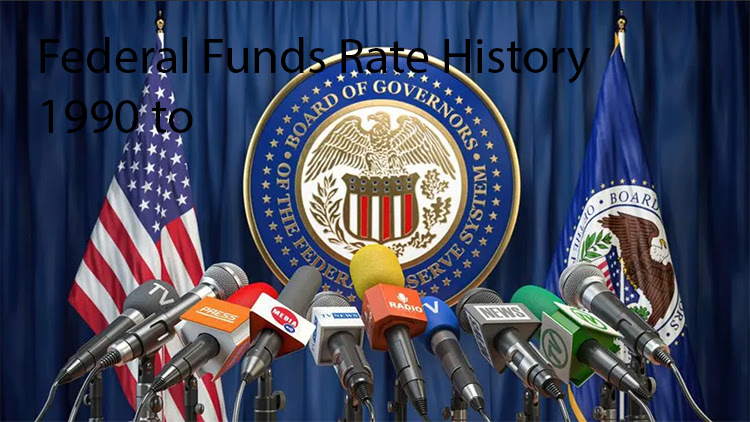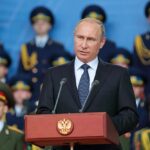Federal Funds Rate History Mark Twain once stated that while history doesn’t repeat itself, it often exhibits similar patterns. This sentiment can be applied to Federal Reserve interest rate policy, albeit with less entertainment value than “The Million Pound Bank Note.” It is crucial for those involved in financial markets to comprehend the trajectory of the Fed’s monetary policy decisions and the rationale behind them. Examining the reasons for the Federal Open Market Committee (FOMC) raising the fed funds target rate in 1994 can offer valuable insights into its current actions. orangebybk has curated a comprehensive guide to the federal funds rate and the Federal Reserve’s monetary policy decisions spanning the past 30 years.
Outlines Of Guide
ToggleUnderstanding Fed Interest Rate Decisions
The Fed adjusts the federal funds target rate range to maintain stable prices and maximize employment. It raises interest rates to combat inflation and encourages saving, while lowering them to stimulate borrowing and spending when the economy is weak. This balance is crucial for driving economic growth and maintaining price stability.
Numerous other variables influence the Federal Reserve’s monetary policy choices, such as GDP, consumer spending, and industrial production, as well as significant occurrences like financial crises, global pandemics, or large-scale terrorist attacks. With that goal in mind, we have organized this collection of historical fed funds data with explanations about the various factors that guided the Fed’s choices. While the central bank is run by authoritative economists, analysts, and business professionals, it is also greatly adaptable to shifting political dynamics.
About the Data
The tables provided below outline the dates of Fed meetings during which the FOMC adjusted interest rates, the magnitude of each rate adjustment in basis points (bps), and the resulting federal funds target rate range. Basis points serve as a widely used unit of measurement for interest rates, with one basis point being equivalent to 1/100th of a percentage point or 0.01%. Prior to 1990, the Fed did not specifically target a fixed federal funds rate. For information on earlier rate policy, refer to the Federal Reserve document obtained through a Freedom of Information Act request.
Fed Rate Hikes 2022-2023: Taming Inflation
| FOMC Meeting Date | Rate Change (bps) | Federal Funds Rate |
|---|---|---|
| July 26, 2023 | +25 | 5.25% to 5.50% |
| May 3, 2023 | +25 | 5.00% to 5.25% |
| March 22, 2023 | +25 | 4.75% to 5.00% |
| Feb 1, 2023 | +25 | 4.50% to 4.75% |
| Dec 14, 2022 | +50 | 4.25% to 4.50% |
| Nov 2, 2022 | +75 | 3.75% to 4.00% |
| Sept 21, 2022 | +75 | 3.00% to 3.25% |
| July 27, 2022 | +75 | 2.25% to 2.50% |
| June 16, 2022 | +75 | 1.50% to 1.75% |
| May 5, 2022 | +50 | 0.75% to 1.00% |
| March 17, 2022 | +25 | 0.25% to 0.50% |
It’s important to remember that the Fed had kept the federal funds rate near zero until the first quarter of 2022 and was purchasing billions of dollars of bonds monthly to boost the economy, despite high U.S. inflation. When the Fed decided to address inflation, it took significant action, raising the fed funds rate by over five percentage points in the past 16 months. This move has helped to decrease high inflation rates and protect the purchasing power of ordinary Americans. Federal Reserve Chair Jerome Powell emphasized the significance of price stability for a functioning economy during a speech at Jackson Hole in August 2022. He highlighted that achieving sustained strong labor market conditions is dependent on price stability.
2020 Fed Rate Cuts: Coping with Covid-19
| FOMC Meeting Date | Rate Change (bps) | Federal Funds Rate |
|---|---|---|
| March 16, 2020 | -100 | 0% to 0.25% |
| March 3, 2020 | -50 | 1.0% to 1.25% |
The Federal Open Market Committee (FOMC) had noted in their policy statement on Jan. 29, 2020, that economic activity was rising at a moderate rate and the labor market remained strong. However, within weeks of this statement, the Covid-19 pandemic hit the world and led to widespread lockdowns recommended by public health officials to curb the virus’s spread. As a result, the United States faced a severe recession with around 20.5 million jobs lost in April 2020 alone and an unemployment rate of 14.7%. This unexpected turn of events had a significant impact on the U.S. economy and caused policymakers to implement new measures to tackle this crisis.
In response to the Covid-19 pandemic, the FOMC conducted two unscheduled emergency meetings in March 2020, resulting in two significant rate cuts that brought the federal funds target rate range to zero to 0.25%. Despite the economy technically showing growth again by May 2020 after experiencing the shortest recession on record, the repercussions of economic measures taken to mitigate the impact of Covid-19 are still being felt today. The pandemic has caused widespread disruptions across different sectors and industries and has led to a significant shift towards remote work arrangements, which could have long-lasting effects on how we work and live. As businesses continue to adapt to these changes, policymakers will need to remain vigilant and proactive in their response to ensure a sustained economic recovery.
2019 Fed Rate Cuts: Mid-Cycle Adjustment
| FOMC Meeting Date | Rate Change (bps) | Federal Funds Rate |
|---|---|---|
| October 31, 2019 | -25 | 1.50% to 1.75% |
| Sept. 19, 2019 | -25 | 1.75% to 2.0% |
| Aug. 1, 2019 | -25 | 2.0% to 2.25% |
In 2019, the Federal Reserve cut interest rates by a quarter of a percentage point three times, which was referred to as a “mid-cycle adjustment” by Powell. The aim was to ease rates midway through the typical expansion-to-recession business cycle. This move was prompted by concerns that the U.S.-China trade war would negatively impact the economy and lead to higher unemployment rates. The three rate cuts that were implemented in the second half of 2019 had a positive effect on the economy, providing much-needed relief amid rising uncertainty and volatility in financial markets.
At the time, inflation was significantly below the central bank’s target of 2%, which was measured by the core personal consumption expenditures price index (PCE) – the Federal Reserve’s preferred gauge of U.S. inflation. In June 2019, core PCE increased by only 1.7% compared to the previous year, and by February 2020, it had risen to just 1.9%. This low inflation rate can be attributed to several factors such as subdued global growth, weak commodity prices, and an aging population in developed nations. Despite these challenges, the Federal Reserve continues to monitor inflation closely and adjust its monetary policy as needed to achieve its target of 2% inflation over the long term.
Fed Rate Hikes 2015-2018: Returning to Normalcy
| FOMC Meeting Date | Rate Change (bps) | Federal Funds Rate |
|---|---|---|
| December 20, 2018 | +25 | 2.25% to 2.50% |
| Sept. 27, 2018 | +25 | 2.0% to 2.25% |
| Jun. 14, 2018 | +25 | 1.75% to 2.0% |
| March 22, 2018 | +25 | 1.50% to 1.75% |
| Dec. 14, 2017 | +25 | 1.25% to 1.50% |
| June 15, 2017 | +25 | 1.00% to 1.25% |
| March 16, 2017 | +25 | 0.75% to 1.00% |
| Dec. 15, 2016 | +25 | 0.5% to 0.75% |
| Dec. 17, 2015 | +25 | 0.25% to 0.50% |
In 2019, the Federal Reserve cut interest rates by a quarter of a percentage point three times, which was referred to as a “mid-cycle adjustment” by Powell. The aim was to ease rates midway through the typical expansion-to-recession business cycle. This move was prompted by concerns that the U.S.-China trade war would negatively impact the economy and lead to higher unemployment rates. The three rate cuts that were implemented in the second half of 2019 had a positive effect on the economy, providing much-needed relief amid rising uncertainty and volatility in financial markets.
At the time, inflation was significantly below the central bank’s target of 2%, which was measured by the core personal consumption expenditures price index (PCE) – the Federal Reserve’s preferred gauge of U.S. inflation. In June 2019, core PCE increased by only 1.7% compared to the previous year, and by February 2020, it had risen to just 1.9%. This low inflation rate can be attributed to several factors such as subdued global growth, weak commodity prices, and an aging population in developed nations. Despite these challenges, the Federal Reserve continues to monitor inflation closely and adjust its monetary policy as needed to achieve its target of 2% inflation over the long term.
Fed Rate Hikes 2015-2018: Returning to Normalcy
| FOMC Meeting Date | Rate Change (bps) | Federal Funds Rate |
|---|---|---|
| Dec. 16, 2008 | -100 | 0% to 0.25% |
| Oct. 29, 2008 | -50 | 1.00% |
| Oct. 8, 2008 | -50 | 1.50% |
The Great Recession officially started in December 2007 and continued until June 2009. However, the Federal Reserve stopped lowering interest rates from April 2008 to October 2008, as the global financial crisis worsened. American households witnessed a decline in their property values, and the stock market did not hit its lowest point until early 2009. The unemployment rate rose from 5% in December 2007 to 10% by October 2009. The FOMC observed in its statement accompanying the decision on December 16, 2008, “Since the Committee’s last meeting, labor market conditions have deteriorated, and the available data indicate that consumer spending, business investment, and industrial production have declined. Financial markets remain quite strained, and credit conditions are tight.”
After the Federal Reserve lowered interest rates to zero, they implemented a new monetary policy known as quantitative easing (QE). QE involved purchasing trillions of dollars’ worth of bonds to help boost the economy and create jobs. However, despite these efforts, many Americans have still not fully recovered from the economic downturn. The impact of the recession on individuals and communities has been long-lasting, with some people never being able to regain their financial footing. The understated nature of this historical event underscores its profound impact on our society and the need for continued efforts to support those who were most affected by it.
Fed Rate Cuts 2007-2008: The Housing Market Crash
| FOMC Meeting Date | Rate Change (bps) | Federal Funds Rate |
|---|---|---|
| Apr. 30, 2008 | -25 | 2.00% |
| Mar. 18, 2008 | -75 | 2.25% |
| Jan. 30, 2008 | -50 | 3.00% |
| Jan. 22, 2008 | -75 | 3.50% |
| Dec. 11, 2007 | -25 | 4.25% |
| Oct. 31, 2007 | -25 | 4.50% |
| Sept. 18, 2007 | -50 | 4.75% |
In June 2006, the Fed concluded its 2005-2006 drive to increase rates. As the housing bubble began to burst and unemployment rates climbed in early 2007, the FOMC responded by lowering rates starting in September 2007. Within a year, rates were reduced by 2.75 percentage points as the economy struggled. In an April 2008 statement, the Fed stated that the significant easing of monetary policy, along with ongoing efforts to support market liquidity, should encourage gradual growth and help alleviate risks to economic activity.
Following the April 2008 rate cut, then Fed Chair Ben Bernanke took a momentary pause to assess the impact of lower interest rates on the economy. Analysts were divided in their opinions, with some predicting higher inflation and others unable to foresee the severity of the impending global financial crisis. Rich Yamarone, the director of economic research at Argus Research, pointed out that policymakers are well aware that prolonged negative real rates lead to significant inflation pressures. He emphasized this point by stating that “when real rates are negative for an extended period of time, inflation pressures rise swiftly and dramatically.” This sentiment was echoed by many other experts in the field who warned of potential consequences of such policies.
Fed Rate Hikes 2005-2006: The Housing Market Boom
| FOMC Meeting Date | Rate Change (bps) | Federal Funds Rate |
|---|---|---|
| Jun. 29, 2006 | +25 | 5.25% |
| May. 10, 2006 | +25 | 5.00% |
| Mar. 28, 2006 | +25 | 4.75% |
| Jan. 31, 2006 | +25 | 4.50% |
| Dec. 13, 2005 | +25 | 4.25% |
| Nov. 1, 2005 | +25 | 4.00% |
| Sept. 20, 2005 | +25 | 3.75% |
| Aug. 9, 2005 | +25 | 3.50% |
| June 30, 2005 | +25 | 3.25% |
| May 3, 2005 | +25 | 3.00% |
| March 22, 2005 | +25 | 2.75% |
| Feb. 2, 2005 | +25 | 2.50% |
| Dec. 14, 2004 | +25 | 2.25% |
| Nov. 10, 2004 | +25 | 2.00% |
| Sept. 21, 2004 | +25 | 1.75% |
| Aug. 10, 2004 | +25 | 1.50% |
| June 30, 2004 | +25 | 1.25% |
Following the dot-com recession of the early 2000s, the US economy made a quick recovery. By mid-2003, the Fed had lowered interest rates and put the fed funds target rate at 1%, which contributed to the GDP growth from +1.7% in 2001 to +3.9% in 2004. However, by 2005, concerns regarding a possible bubble in US housing markets emerged due to high or record levels of price relative to rent, construction cost, and income. Economist Robert Shiller warned about these issues in a June 2005 interview with NPR, stating that people were becoming more aware of them.
The Federal Reserve attempted to curb the burgeoning real estate bubble and cool off the economy by increasing interest rates 17 times over a two-year period, resulting in a four-percentage-point increase in the fed fund target rate. Despite this hawkish approach, inflation remained relatively under control, with core PCE inflation peaking at 2.67% in August 2006. By the end of this cycle of rate hikes, the unemployment rate had dropped to 4.6%, and PCE inflation began to decline towards the Fed’s target of 2%. This suggests that while raising interest rates can have an impact on economic growth, it needs to be done judiciously and with a clear understanding of its short- and long-term consequences.
Fed Rate Cuts 2002-2003: Flagging Recovery, Low Inflation
| FOMC Meeting Date | Rate Change (bps) | Federal Funds Rate |
|---|---|---|
| June 25, 2003 | -25 | 1.00% |
| November 6, 2002 | -50 | 1% |
The recession that occurred in the dot-com industry from March to November 2001 had a significant impact on the fragile US economy. Despite some signs of improvement, consumer confidence remained low, prompting concern for the Federal Reserve. In November 2002, the FOMC surprised many analysts by deciding to reduce rates by 50 basis points, citing “greater uncertainty” and “geopolitical risks.” This move was a response to the increasing economic uncertainty and geopolitical risks that posed a threat to the emerging recovery. While aimed at stimulating growth and restoring consumer confidence, the decision also highlighted the challenges faced by policymakers at that time. Although initially confusing to the markets, this action ultimately contributed to a more resilient and sustained economic recovery. The brief statement from the Fed indicated its dedication to supporting the economy during periods of volatility and uncertainty.
In the middle of 2003, the US economy was experiencing an uncomfortably low level of inflation. Core PCE, a measure of inflation, stood at 1.78% in January and then fell to 1.47% nine months later. Fearing the possibility of deflation, the Federal Open Market Committee (FOMC) decided to cut rates by a modest 25 basis points. This move resulted in the fed funds rate reaching its lowest point in 45 years.The FOMC justified its decision citing subdued inflationary expectations and seeking to implement a more expansionary monetary policy that would provide further support to the economy. The committee expressed confidence that this policy shift would contribute towards an eventual improvement in economic growth over time, as reflected in their statement.
2001 Fed Rate Cuts: The Dot-Com Bust and 9/11
| FOMC Meeting Date | Change (bps) | Federal Funds Rate |
|---|---|---|
| Dec. 11, 2001 | -25 | 1.75% |
| Nov. 6, 2001 | -50 | 2.00% |
| Oct. 2, 2001 | -50 | 2.50% |
| Sept. 17, 2001 | -50 | 3.00% |
| Aug. 21, 2001 | -25 | 3.50% |
| June 27, 2001 | -25 | 3.75% |
| May 15, 2001 | -50 | 4.00% |
| April 18, 2001 | -50 | 4.50% |
| March 20, 2001 | -50 | 5.00% |
| Jan. 31, 2001 | -50 | 5.50% |
| Jan. 3, 2001 | -50 | 6.00% |
The dot-com bubble of the late 1990s and early 2000 was followed by the dot-com bust in 2001, which led to a stock market crash. The irrational exuberance that characterized this period resulted in vast amounts of money being invested in increasingly unviable dot-com ventures. The Nasdaq Composite reached its peak in February 2000, but it took until September 2002 for it to hit bottom. The fallout from the stock market meltdown extended into the real economy, causing a mild contraction in GDP and higher levels of unemployment, leading to an eight-month-long recession. However, lessons were learned from this experience, and investors became more cautious about investing in speculative technology stocks without proper analysis and due diligence.
The aftermath of the 9/11 terrorist attacks had a significant impact on the economy, which was already struggling. To mitigate the effects, The Federal Reserve took action by lowering interest rates by a total of 5.25 percentage points throughout 2001. This steady drumbeat of rate cuts aimed to stimulate economic growth and increase liquidity in financial markets. Along with other measures taken by the government and private sector, such as increased spending and job creation initiatives, these actions helped to stabilize the economy in the aftermath of one of the worst tragedies in American history.
Fed Rate Hikes 1999-2000: The Dot-Com Boom
| FOMC Meeting Date | Change (bps) | Federal Funds Rate |
|---|---|---|
| May 16, 2000 | +50 | 6.50% |
| March 21, 2000 | +25 | 6.00% |
| Feb. 2, 2000 | +25 | 5.75% |
| Nov. 16, 1999 | +25 | 5.50% |
| Aug. 24, 1999 | +25 | 5.25% |
| June 30, 1999 | +25 | 5.00% |
During the period between 1995 and March 2000, the Nasdaq experienced an unprecedented rise of 400% due to a frenzy of speculation that drove up the value of tech companies and internet stocks. However, as this bubble continued to inflate, the Federal Reserve started increasing rates in June 1999. Former Fed Chair Alan Greenspan aimed to prevent inflation expectations from becoming entrenched, especially with the unemployment rate hovering around 4% and inflation inching towards the Fed’s 2% target. Hence, this tightening cycle was capped off with a significant raise of 50 basis points. This move was aimed at putting an end to this boom period and preventing further damage to the economy caused by irrational exuberance.
The announcement made by the Fed that they would not raise interest rates further was met with a positive response from investors, leading to a “relief rally” in the stock market. Although some analysts had predicted that rates might continue to rise, the Fed ultimately chose to hold off as inflation levels stabilized. This decision provided a sense of reassurance to market participants who were concerned about the potential impact of rising interest rates on economic growth and corporate earnings.
1998 Fed Rate Cuts: Global Currency Crisis
| FOMC Meeting Date | Rate Change (bps) | Federal Funds Rate |
|---|---|---|
| November 17, 1998 | -25 | 4.75% |
| October 15, 1998 | -25 | 5.00% |
| September 29, 1998 | -25 | 5.25% |
The 1998 rate cut cycle was an anomaly since the driving forces behind the FOMC’s actions primarily stemmed from international economic tensions. A sequence of interconnected events led to three rate cuts in fall 1998, which began with a currency crisis in Thailand that spread throughout Asia and Latin America. This crisis then triggered a similar currency crisis in Russia towards the end of 1998. Furthermore, these issues brought Long-Term Capital Management (LTCM), a major U.S. hedge fund, to the brink of insolvency. The FOMC’s decision to lower interest rates was made in response to these global economic shocks and to prevent further damage from spreading into the domestic economy.
The Federal Reserve’s statement in September 1998 announcing a rate cut was brief by today’s standards. The statement simply stated that the action was taken to mitigate the impact of weakening foreign economies and less accommodating financial conditions domestically on future economic growth in the United States. This announcement highlights the central bank’s role in stabilizing the economy during times of uncertainty and volatility. It also underscores the importance of monitoring both domestic and global economic conditions when making monetary policy decisions.
1997 Fed Rate Hike: FOMC Lightly Taps the Brakes
| FOMC Meeting Date | Rate Change (bps) | Federal Funds Rate |
|---|---|---|
| March 25, 1997 | +25 | 5.50% |
During the 1990s, the U.S. economy experienced a decade-long expansion that was marked by low inflation and steady growth. In March 1997, inflation hovered around 1.94% and was gradually rising. To maintain price stability and keep inflation close to its target of 2%, the Federal Reserve implemented policies aimed at controlling the money supply and adjusting interest rates accordingly. These measures helped to support economic growth while keeping inflation in check, contributing to a period of sustained prosperity for the nation.
The Federal Reserve’s statement suggests that the slight tightening of monetary conditions is a wise move to ensure that the current economic expansion continues. By maintaining a low inflation environment through 2021 and beyond, this step provides greater assurance that the economy will remain stable. The Fed’s decision to take action now is seen as a prudent measure to avoid any potential issues down the line.
Fed Rate Cuts 1995-1996: Mid-Cycle Adjustment, 90s-Style
| FOMC Meeting Date | Rate Change (bps) | Federal Funds Rate |
|---|---|---|
| Jan. 31, 1996 | -25 | 5.25% |
| Dec. 19, 1995 | -25 | 5.50% |
| July 6, 1995 | -25 | 5.75% |
Despite the 1990s being characterized as a period of explosive economic expansion and productivity growth, the middle of this decade saw three rate cuts over six months, which was somewhat unexpected. The Federal Reserve focused on combating inflation in 1994 and early 1995. In their July 1995 decision, the FOMC expressed that “as a result of the monetary tightening initiated in early 1994, inflationary pressures have receded enough to accommodate a modest adjustment in monetary conditions.” This suggests that while inflation had been reduced enough to allow for some adjustment, it remained a concern for the Fed during this time period.
Despite passing of six months, the unemployment rate remained unchanged at 5.6% which compelled the Fed to consider additional stimulus measures. This decision was influenced by the recent retail sales, which fell short of expectations, indicating sluggish economic growth. The Fed’s decision reflects its commitment to supporting the country’s economy and maintaining stability in financial markets.
Fed Rate Hikes 1994-1995: A Soft Landing
| FOMC Meeting Date | Rate Change (bps) | Federal Funds Rate |
|---|---|---|
| Feb. 1, 1995 | +50 | 6.00% |
| Nov. 15, 1994 | +75 | 5.50% |
| Aug. 16, 1994 | +50 | 4.75% |
| May 17, 1994 | +50 | 4.25% |
| April 18, 1994 | +25 | 3.75% |
| March 22, 1994 | +25 | 3.50% |
| Feb. 4, 1994 | +25 | 3.25% |
The period of monetary policy tightening from 1994-1995 is often remembered as a rare example of the Fed achieving a “soft landing” for the economy. Under Greenspan’s leadership, the FOMC raised the fed funds rate nearly two-fold in seven increments between February 1994 and February 1995. Following a short recession earlier in the decade, the U.S. economy experienced significant growth, with GDP increasing by +3.5% in 1992, +2.8% in 1993, and a substantial +4% in 1993. During this time, baby boomers were at the peak of their careers, immigration was strong, and new technology was revolutionizing the economy.
In February 1994, the Fed decided to hike interest rates for the first time in real-time due to robust productivity rates that kept unemployment at low levels. This decision was made to sustain and enhance the economic expansion as part of a less accommodative stance in monetary policy. However, despite this announcement, markets were caught off-guard by the rate hikes, and the result was the 1994 Bond Crash. The episode serves as a reminder of how even small changes in monetary policy can have significant impacts on financial markets. It highlights the importance of closely monitoring economic indicators and staying informed about central bank policies to make informed investment decisions.
Fed Rate Cuts 1990-1992: The Gulf War Recession
| FOMC Meeting Date | Rate Change (bps) | Federal Funds Rate |
|---|---|---|
| Sept. 4, 1992 | -25 | 3.00% |
| July 2, 1992 | -50 | 3.25% |
| April 9, 1992 | -25 | 3.75% |
| Dec. 20, 1991 | -50 | 4.00% |
| Dec. 6, 1991 | -25 | 4.50% |
| Nov. 6, 1991 | -25 | 4.75% |
| Oct. 31, 1991 | -25 | 5.00% |
| Sept. 13, 1991 | -25 | 5.25% |
| Aug. 6, 1991 | -25 | 5.50% |
| April 30, 1991 | -25 | 5.75% |
| March 8, 1991 | -25 | 6.00% |
| Feb. 1, 1991 | -50 | 6.25% |
| Jan. 9, 1991 | -25 | 6.75% |
| Dec. 18, 1990 | -25 | 7.00% |
| Dec. 7, 1990 | -25 | 7.25% |
| Nov. 13, 1990 | -25 | 7.50% |
| Oct. 29, 1990 | -25 | 7.75% |
| July 13, 1990 | -25 | 8.00% |
The Federal Reserve’s interest rate decisions lacked transparency before 1994, leaving analysts to interpret the Fed’s moves without the aid of a policy statement or press conference. During most of the 1980s, the Fed also did not utilize the federal funds rate to establish interest rate policy. However, in the current era, there is greater transparency and communication surrounding the Fed’s decisions. The Fed now issues policy statements and holds regular press conferences to better inform the public about its actions and reasoning. This increased openness has helped investors and businesses make more informed decisions based on the Fed’s actions, leading to greater stability in financial markets.
The Federal Reserve typically cuts interest rates to jumpstart the economy. This was evident during the Gulf War recession that lasted from July 1990 to March 1991, where it took households some time to recover. The unemployment rate rose from 5.2% in June 1990 to 7.8% two years later. Despite the Fed’s efforts, it can take time for the economy and individuals to recover from a recession or economic downturn. It is important to note that interest rate cuts alone may not be enough to stimulate economic growth, and other measures such as fiscal policy may also be needed.
Federal Funds Rate History in 2025: FAQs
What is the Federal Reserve?
The Federal Reserve, also referred to as the Federal Reserve System, serves as the central bank of the United States and encompasses 12 regional divisions nationwide. The central governing board, the FOMC, and the 12 regional Fed banks were established by the 1913 Federal Reserve Act.
What does the Federal Reserve do?
The Fed has five main tasks.
- Manage U.S. monetary policy by adjusting interest rates and using other policy tools.
- Oversee the smooth functioning of the U.S. financial system.
- Regulate large financial institutions and banks.
- Ensure the smooth functioning of the payments system.
- Administer certain consumer laws, and undertake research to support its overall mission.
What is the FOMC?
The FOMC is responsible for establishing monetary policy and convenes eight times annually to determine the federal funds rate and the Fed’s balance sheet.
The FOMC is made up of 12 members, who are:
- The seven members of the Fed Board of Governors, led by the Fed chairperson.
- The president of the Federal Reserve Bank of New York.
- Four seats are filled by the other 11 regional Federal Reserve Bank presidents, who serve one-year terms on a rotating basis.
When is the next Fed meeting?
The FOMC holds eight regularly scheduled meetings annually, each lasting two days and typically concluding on a Wednesday. Here is the 2023 FOMC meeting schedule:
- January 31 to February 1
- March 21-22
- May 2-3
- June 13-14
- July 25-26
- September 19-20
- October 31 to November 1
- December 12-13
Four of the meetings involve a Summary of Economic Projections, which indicates the economic growth, unemployment rate, and inflation expectations of FOMC participants for the near and medium-term future.
Why was the Federal Reserve created?
The Federal Reserve System was established in 1913 with the aim of establishing a more secure monetary and financial system for the nation. Recessions were a regular occurrence before the establishment of the Fed, some of which severely impacted the nation’s economy and people’s prosperity. For example, there was a two-year recession in January 1910, a 13-month downturn in May 1907, and a 23-month contraction in September 1902.











































